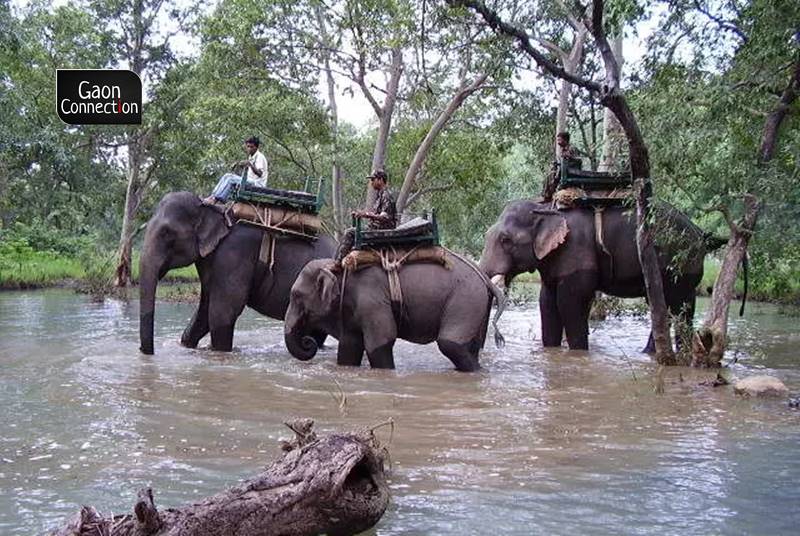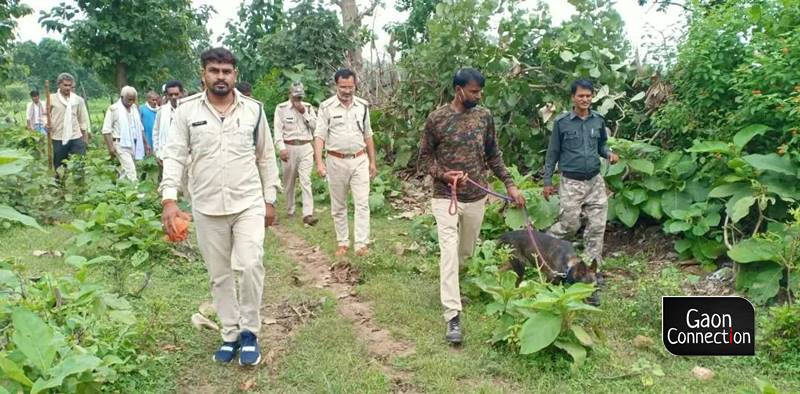The monsoon patrol of the Panna Tiger Reserve is incredibly challenging for its forest guards
Forest guards of the Panna Tiger Reserve in Madhya Pradesh wade through slush, swollen streams and dense thickets, as they patrol over 542 sq kms of the reserve’s core area and another 1,021 sq kms of its buffer zone, and never too far away from belligerent wild bears and venomous snakes.


A real friend of the forest patrols especially during the monsoons is the elephant. All photos by Arun Singh
Panna, Madhya Pradesh
The monsoon season is perhaps the most difficult time for forest guards. Deep inside the forests, slush, overflowing streams, prowling bears, snakes and scorpions, make it difficult for any vehicle to navigate its way around.
Looking after the security of the animals, especially the tigers in this season is a big challenge. More so because this is when the jungle mafia and poachers take advantage of the difficulties and step up their illegal activities.
Also Read: Buffer zones around tiger reserves in Madhya Pradesh open for monsoon tourism
“The heavy rains makes visibility poor inside the dense forests,” Uttam Kumar Sharma, field officer, Panna Tiger Reserve (PTR) in Madhya Pradesh, told Gaon Connection. “Forest guards do their rounds on foot as no vehicle can go inside. And, because there is water available freely, animals are roaming everywhere, and not just at the watering holes,” Sharma added. This makes monitoring them difficult, he said.

At the reserve, the three months between July 1 and September 30, are testing times for the forest guards. It is not easy to patrol the jungles on foot, when tigers are on the prowl looking for prey. Madhya Pradesh is called the tiger state with the highest tiger population. The reserve is on monsoon alert for the duration.
Also Read: Heera and Panna, the inseparable tiger siblings of Panna Tiger Reserve, part ways
“Patrolling on foot is particularly difficult and the guards have to be alert always, as there are many bears in the Panna forests, as well as snakes,” Uttam Kumar said.

The core area of PTR is over 542 sq kms while its buffer zone covers 1,021 sq kms. In order to patrol every nook and cranny of it, there are 142 patrolling camps, 47 surveillance camps and 83 temporary camps inhabited by forest guards.
The temporary camps have shelters for the guards made of wood and grass, that are no protection against huge rats that come out during the monsoons and enter the camps to raid the food supplies. The constant rain and damp make cooking a challenge and there is the ever present danger of poisonous snakes.
Straying cattle and humans are a menace
“Cattle owners often allow their animals to stray into the forests to graze, and then come looking for their cattle after it gets dark which makes it dangerous as they could be attacked by bears,” a forest guard on condition of anonymity told Gaon Connection.

Also Read: Tiger Dad wins custody of his cubs at Panna Tiger Reserve
Despite rules prohibiting them from entering the forests, people from nearby villages continue to take their cattle in. On July 20, in the forests of Bagaunha Beat, a part of Panna Tiger Reserve, a bear attack left a 55-year-old cowherd dead. Hardas Ahirwar had strayed into the forest looking for his buffaloes, when the bear killed him on the spot.
There are many instances of human-animal encounters in the forest, and forest guards find it difficult to prevent them. Besides this, even during the monsoons, people visit the area to see the many waterfalls that are in full flow during the monsoons and often have picnics there. There are also places of religious interest that attract visitors. The forest guards have to keep an eye on them as well.
Also Read: Sulochana and Ayyub: The lovely bond between a jumbo and her mahout
Elephants, the guards’ best friends
A real friend of the forest patrols especially during the monsoons is the elephant. Many parts of the forests become inaccessible due to the rains and the washing away of any pathways. In such cases it is the trained elephants of Panna Tiger Reserve that patrol the area.
“Elephants are a vital component of monsoon patrols in the forests of Panna,” Sanjeev Kumar Gupta, wildlife physician at the tiger reserve, told Gaon Connection. Patrolling the most sensitive and inaccessible areas of the forests becomes possible thanks to the elephants, he continued.
Also Read: Vatsala, Panna Tiger Reserve’s senior- most citizen is more than a 100 years old
The monsoon brigade at Panna Tiger Reserve are the elephants Ram Bahadur, Mohankali, Anarkali, Roopkali, Ananthi, Prahlad, Vanya and Kenkali.
“The reserve’s elephants are trained to negotiate mountainous terrain, navigate overflowing streams and move through tall grasses during the monsoons,” Buddha Ram Yadav, mahout at the tiger reserve, told Gaon Connection. “They are able to reach sensitive areas and prevent poaching and illegal activities; they are also sensitive to the location of the tigers,” Yadav said.
Describing the modus operandi of Anarkali and Roopkali, another mahout Soore Adivasi, said, “The minute they sense the presence of hunters or tree smugglers, the two start raining stones in the direction of the culprits forcing them to flee.”
The herd of elephants in Panna Tiger Reserve includes the venerable Vatsala who is more than a 100 years old. The youngest is just under a year old and was born to Roopkali on September 18, last year.
Read the story in Hindi.

